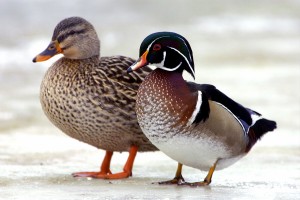The October trickle of ducks was followed by the biggest migration in recent years as winter storm Astro blanketed the northern tier with snow and ice. While the storm system produced extraordinary results, the timing was, in fact, quite ordinary. Going back to the great Armistice Day storm of 1940, the first arctic clipper of the season and biggest migration push generally occurs around the second week of November. Of course, the severity of the storm often varies. The number of ducks and geese that are pushed by this November clipper system is decided by one single factor – snow. Thankfully, winter storm Astro brought a lot of it, and along with it, a significant number of waterfowl.
Hello folks, and, as always, welcome to Waterfowler.com.
What do you get when you combined a record number of waterfowl and a classic, powerful winter storm? Most of our readers would say, “I good reason to be a duck hunter.” This past week witnessed the best migration in recent years and while things my be winding down for the far northern hunter a bit early, waterfowl season has only begun in the central and southern portions of the United States.
Let’s face it, Duck hunters love weather as much as weather reporters and you didn’t need the Internet to tell you that ducks and geese were going to move last week. Any waterfowl hunter worth the price of their waders could have told you it was going to be great week by simply watching a national weather report. Yet social media and duck hunting websites and our own hunting reports light up over the past week as ducks and geese moved south. The information wasn’t exclusive, unpredictable or unexpected – but it’s what we wait for, all year long.
So without further ado, let’s run down the results of winter storm Astro so you can hunt were the ducks are and partake in the excitement of that seasona sensation we call, “The Great North American Waterfowl Migration.”
PACIFIC FLYWAY
From western Montana to the Great Salt Lake of Utah, hunters are battling ice and finding the best hunting of the season around open water. Mallards are thick, and the rewards are great for those chasing greenheads at this time. Hunting is fair to good in Washington for both ducks and geese but hunter success dwindles as you move into Oregon and northern California. Duck numbers are below average for this time of year from the Klamath Basin to Sacramento Valley due to ongoing drought conditions. Migrating ducks continue to move through Southern California, Nevada and Arizona but most will continue south in search of water.
CENTRAL FLYWAY
Snow and ice continue to put a grip on the Dakotas and the greatest migration in recent years will pass quickly in snow-covered areas. The snow goose migration reached peak activity over the weekend and mid continental light geese will push into Texas over the next few days. Mallard numbers are good to excellent in Nebraska, Kansas and Colorado and nearing peak. In Oklahoma and Texas, widgeon, gadwall, redheads and pintail are good to excellent and overall numbers are increasing daily. In short, now is the time to hunt in the Central Flyway – it’s game on.
MISSISSIPPI FLYWAY
Old man winter is has taken a firm hold in Minnesota but the best duck hunting can be found right now. Mallards are strung out from the one end of the flyway to other and while these birds will move out of Minnesota and Wisconsin in the coming days, the fat lady has yet to sing in the north. Goose numbers are good to excellent and will continue to provide late season hunting until accumulating snow forces them south. In Iowa, Illinois and Michigan (where snow cover is lower and open water more prevelant) excellent hunting will continue until snow arrives. From Arkansas to Louisiana, ducks continue to arrive daily and the best season in years is shaping up nicely.
ATLANTIC FLYWAY
As usual, migration activity is running later in eastern states. Duck numbers are on the rise throughout the New England States and Wood duck flights good to excellent all the Way to Chesapeake Bay. Mallard and black duck numbers are increasing from Pennsylvania to the Jersey shore (and all points in between). From Delaware to the Carolinas, limits of ducks can be had and include a variety of species. From Georgia to Florida, teal, wood ducks and ringed-necks are good to excellent at this time with all other species fair.
Until our next report, get out and hunt.






